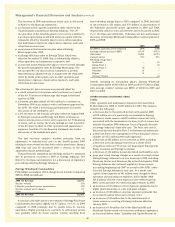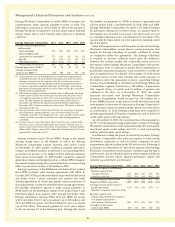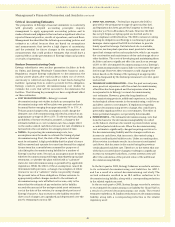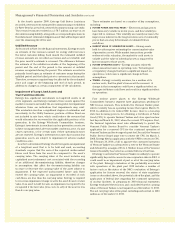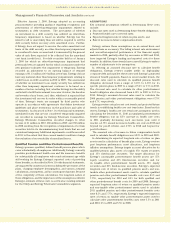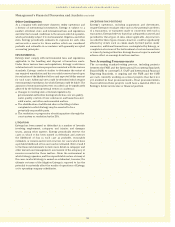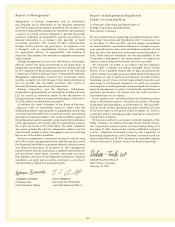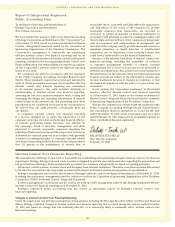Entergy 2010 Annual Report Download - page 47
Download and view the complete annual report
Please find page 47 of the 2010 Entergy annual report below. You can navigate through the pages in the report by either clicking on the pages listed below, or by using the keyword search tool below to find specific information within the annual report.
ENTERGY CORPORATION AND SUBSIDIARIES 2010
Management’s Financial Discussion and Analysis continued
The LPSC has appealed the FERC’s decision to the U.S. Court of
Appeals for the District of Columbia.
The APSC had previously commenced an investigation, in 2004,
into whether Entergy Arkansas’s continued participation in the
System Agreement is in the best interests of its customers. The
Entergy Arkansas president, Hugh McDonald, filed testimony with
the APSC in response to requests by the APSC. In addition, Mr.
McDonald has appeared before the APSC at public hearings for
questioning. In December 2007, the APSC ordered Mr. McDonald
to file testimony each month with the APSC detailing progress
toward development of successor arrangements, beginning in
March 2008, and Mr. McDonald has done so. In his September
2009 testimony Mr. McDonald reported to the APSC the results of
a related study. According to the study the total estimated cost
to establish the systems and staff the organizations to perform
the necessary planning and operating functions for a stand-alone
Entergy Arkansas operation are estimated at approximately
$23 million, including $18 million to establish generation-
related functions and $5 million to modify transmission-related
information systems. Incremental costs for ongoing staffing
and systems costs are estimated at approximately $8 million.
Cost and implementation schedule estimates will continue
to be re-evaluated and refined as additional, more detailed
analysis is completed. The study did not assess the effect
of stand-alone operation on Entergy Arkansas’s generation
resource requirements. Entergy Arkansas expects it would take
approximately two years to implement stand-alone operations
for Entergy Arkansas.
In February 2010 the APSC issued an order announcing a
refocus of its ongoing investigation of Entergy Arkansas’s
post-System Agreement operation. The order describes the
APSC’s “stated purpose in opening this inquiry to conduct an
investigation regarding the prudence of [Entergy Arkansas]
entering into a successor ESA [Entergy System Agreement] as
opposed to becoming a stand-alone utility upon its exit from the
ESA, and whether [Entergy Arkansas], as a standalone utility,
should join the SPP RTO. It is the [APSC’s] intention to render a
decision regarding the prudence of [Entergy Arkansas] entering
into a successor ESA as opposed to becoming a stand-alone
utility upon its exit from the ESA, as well as [Entergy Arkansas’]
RTO participation by the end of calendar year 2010. In parallel
with this Docket, the [APSC] will be actively involved and will
be closely watching to see if any meaningful enhancement
will be made to a new Enhanced Independent Coordinator of
Transmission (“E-ICT”) Agreement through the efforts of the
[Entergy Transmission System] stakeholders, Entergy, and the
newly formed and federally-recognized [Entergy Regional State
Committee] in 2010.” Later, in April 2010, the APSC issued an
order that directs Entergy Arkansas also to consider joining the
Midwest ISO RTO as a stand-alone utility.
Entergy Arkansas filed testimony and participated in a March
2010 evidentiary hearing in the proceeding. Entergy Arkansas
noted in its testimony that it was not reasonable to complete a
comprehensive evaluation of strategic options by the end of 2010
and that forcing a decision would place parties in the untenable
position of making critical decisions based on insufficient
information. Entergy Arkansas outlined three options for post-
System Agreement operation of its electrical system: 1) Entergy
Arkansas self providing its generation planning and operating
functions as a stand-alone company; 2) Entergy Arkansas plus
coordination agreements with third parties in which Entergy
Arkansas self provides some planning and operations functions,
but also enters into one or more coordinating or pooling
agreements with third parties; and 3) Successor Arrangements
under which Entergy Arkansas plans for its own generation
resources but enters into a new generation commitment and
dispatch agreement with other Utility operating companies
under a successor agreement intended to avoid the litigation
previously experienced. Entergy Arkansas’s plan is expected
to lead to a decision in late 2011 regarding which option to
implement; however, Entergy Arkansas anticipates pursuing
during this time several elements that are common to all options.
In an attempt to reach understanding of complex issues, Entergy
Arkansas proposed to hold a series of technical conferences
targeting specific subjects. Technical conferences have been held
and another evidentiary hearing in the proceeding was held in
August 2010.
An additional technical conference is scheduled in March
2011. As stated by an APSC order: “The scope of the technical
conference includes the Charles River Associates (“CRA”) Federal
Energy Regulatory Commission (“FERC”) - directed cost/benefit
study of all Entergy Operating Companies (‘‘Entergy OpCos”)
becoming full members in the Southwest Power Pool Regional
Transmission Organization (“SPP RTO”); the CRA APSC-directed
addendum study considering Entergy Arkansas, Inc. (“EAI”) as a
stand-alone member of the SPP RTO; and the CRA APSC-directed
addendum study considering EAI as a stand-alone member of the
Midwest Independent Transmission System Operator (“MISO”);
as well as the CRA EAI/Entergy Services, Inc. (“ESI”)-directed
additional addendum studies (including a cost/benefit study of
all Entergy Op Cos becoming members of MISO).”
A procedural schedule has been established in the proceeding
that, among other things: (1) requires Entergy Arkansas to file
its assessment and recommendations regarding each of the
strategic reorganization options by May 12, 2011 and (2) sets an
evidentiary hearing to begin September 7, 2011.
The Utility operating companies continue to meet with various
interested parties to discuss a proposed framework for successor
arrangements to the current System Agreement. An initial draft
of the successor arrangements, referred to as the Commitment,
Operations, and Dispatch Agreement or “CODA,” was provided
to state regulators on September 16, 2010. The draft CODA was
based on three overarching principles: voluntary coordinated
resource planning; centralized commitment, operations, and
dispatch (so that the resources of all Utility operating companies
are operated to serve the combined loads of those companies);
and coordinated transmission operations. In contrast to the
current System Agreement, which requires joint generation
resource planning, the draft CODA is intended to establish a
resource planning regime that reflects the resource needs of each
Utility operating company’s jurisdictional customers so that each
Utility operating company would realize the benefits and costs of
its own generation planning decisions.
Prior to that time, in early April 2010, Entergy Corporation and
the Utility operating companies determined in connection with
their decision-making process that it is appropriate to agree and
commit that no Utility operating company will enter voluntarily
into successor arrangements with the other Utility operating
companies if its retail regulator finds successor arrangements
are not in the public interest. Hugh McDonald, Entergy Arkansas
president, notified the APSC of this decision, and explained
the decision and commitment, in a letter filed with the APSC on
April 26, 2010.
45



